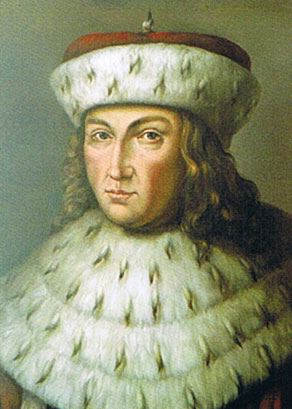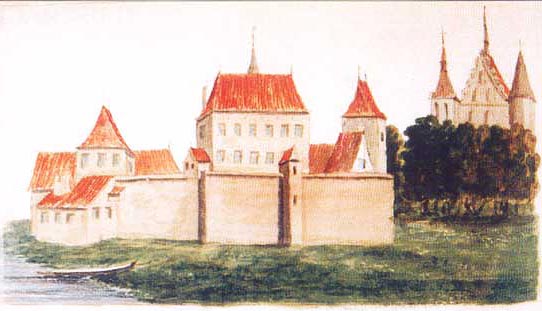|
Bydgoszcz Cathedral
St. Martin and St. Nicholas Cathedral ( pl, Katedra św. Marcina i Mikołaja), or simply known as Bydgoszcz Cathedral, is a Catholic church built in the 15th century. It has a Gothic style, serves as a parish church and cathedral of the Diocese of Bydgoszcz. It also houses a shrine dedicated to the Virgin Mary. Its address is 10 Farna Street. It is the most valuable architectural monument of the Old Town, standing on the Brda riverside. It has been elevated as a cathedral on March 25, 2004, by decision of then Pope John Paul II. Since November 3, 1960, the cathedral has been registered on the Kuyavian-Pomeranian heritage list. History Construction of the first temple The Bydgoszcz parish church was founded by first mayors of the city, Jan Kiesselhuth and Konrad, at the same time the parish itself was created, after Bydgoszcz establishment in 1346. The church building and its adjoining cemetery (active until 1809) were located in the north-western corner of city market pla ... [...More Info...] [...Related Items...] OR: [Wikipedia] [Google] [Baidu] |
Bydgoszcz
Bydgoszcz ( , , ; german: Bromberg) is a city in northern Poland, straddling the meeting of the River Vistula with its left-bank tributary, the Brda. With a city population of 339,053 as of December 2021 and an urban agglomeration with more than 470,000 inhabitants, Bydgoszcz is the eighth-largest city in Poland. It is the seat of Bydgoszcz County and the co-capital, with Toruń, of the Kuyavian-Pomeranian Voivodeship. The city is part of the Bydgoszcz–Toruń metropolitan area, which totals over 850,000 inhabitants. Bydgoszcz is the seat of Casimir the Great University, University of Technology and Life Sciences and a conservatory, as well as the Medical College of Nicolaus Copernicus University in Toruń. It also hosts the Pomeranian Philharmonic concert hall, the Opera Nova opera house, and Bydgoszcz Airport. Being between the Vistula and Oder (Odra in Polish) rivers, and by the Bydgoszcz Canal, the city is connected via the Noteć, Warta, Elbe and German canals with t ... [...More Info...] [...Related Items...] OR: [Wikipedia] [Google] [Baidu] |
Eric II, Duke Of Pomerania
Eric II or Erich II (between 1418 and 1425 – 5 July 1474) was a member of the House of Pomerania (also known as the House of Griffins) and was the ruling Duke of Pomerania-Wolgast from 1457 to 1474. He was the son of Wartislaw IX of Pomerania-Wolgast and Sophia, daughter of Eric IV of Saxe-Lauenburg. Life In 1451, Wartislaw IX arranged his son's marriage to Sophia, daughter of Bogislaw IX of Pomerania-Stolp and heiress of Eric I of Pomerania-Stolp, who had also been king of the Kalmar Union. The marriage of these distant relatives granted Eric II access to Eric I's lands in Farther Pomerania. Also, Eric I arranged the Lauenburg-Bütow Land at the Pomerelian border to be granted by the Polish king to Eric II on 3 January 1455 as a reward for aiding Poland in her struggles with the Teutonic Knights. In 1456, Eric took over Maszewo Land in Farther Pomerania, despite Wassow being not included in his share of Pomerania. This led to conflicts with Otto III, Duke of Pomera ... [...More Info...] [...Related Items...] OR: [Wikipedia] [Google] [Baidu] |
Frederick II, Elector Of Brandenburg
Frederick II of Brandenburg () (19 November 1413 – 10 February 1471), nicknamed "the Iron" (''der Eiserne'') and sometimes "Irontooth" (''Eisenzahn''), was a Prince-elector of the Margraviate of Brandenburg from 1440 until his abdication in 1470, and was a member of the House of Hohenzollern. Biography Frederick II was born at Tangermünde Castle (German: ''Burg Tangermünde''), when Tangermünde was within the Margraviate of Brandenburg, to Frederick I, Brandenburg's first Hohenzollern ruler, and his wife Elizabeth, daughter of Frederick, Duke of Bavaria-Landshut, and Maddalena Visconti. The latter was a daughter of Bernabò Visconti and Beatrice della Scala. As the second son, his brothers included John the Alchemist and Albert Achilles, both of whom also ruled Brandenburg as margraves. In 1421, at age 8, Frederick was betrothed to Hedwig Jagiellon, but she died on 8 December 1431, before the marriage could take place. When Frederick I retired in 1437, he compensated hi ... [...More Info...] [...Related Items...] OR: [Wikipedia] [Google] [Baidu] |
Casimir IV Jagiellon
Casimir IV (in full Casimir IV Andrew Jagiellon; pl, Kazimierz IV Andrzej Jagiellończyk ; Lithuanian: ; 30 November 1427 – 7 June 1492) was Grand Duke of Lithuania from 1440 and King of Poland from 1447, until his death. He was one of the most active Polish-Lithuanian rulers, under whom Poland, by defeating the Teutonic Knights in the Thirteen Years' War recovered Pomerania, and the Jagiellonian dynasty became one of the leading royal houses in Europe. The great triumph of his reign was bringing Prussia under Polish rule. The rule of Casimir corresponded to the age of "new monarchies" in western Europe. By the 15th century, Poland had narrowed the distance separating it from western Europe and become a significant factor in international relations. The demand for raw materials and semi-finished goods stimulated trade, producing a positive balance, and contributed to the growth of crafts and mining in the entire country. He was a recipient of the English Order of the Gart ... [...More Info...] [...Related Items...] OR: [Wikipedia] [Google] [Baidu] |
Teutonic Order
The Order of Brothers of the German House of Saint Mary in Jerusalem, commonly known as the Teutonic Order, is a Catholic religious institution founded as a military society in Acre, Kingdom of Jerusalem. It was formed to aid Christians on their pilgrimages to the Holy Land and to establish hospitals. Its members have commonly been known as the Teutonic Knights, having a small voluntary and mercenary military membership, serving as a crusading military order for the protection of Christians in the Holy Land and the Baltics during the Middle Ages. Purely religious since 1810, the Teutonic Order still confers limited honorary knighthoods. The Bailiwick of Utrecht of the Teutonic Order, a Protestant chivalric order, is descended from the same medieval military order and also continues to award knighthoods and perform charitable work. Name The name of the Order of Brothers of the German House of Saint Mary in Jerusalem is in german: Orden der Brüder vom Deutschen Haus der He ... [...More Info...] [...Related Items...] OR: [Wikipedia] [Google] [Baidu] |
Thirteen Years' War (1454–66)
Thirteen Years' War may refer to: *the Thirteen Years' War (1454–1466) between the Prussian Confederation and Poland versus the Teutonic Order state *the Long Turkish War (1593–1606) between the Habsburg Monarchy and the Ottoman Empire *the Russo-Polish War (1654–1667) The Russo-Polish War of 1654–1667, also called the Thirteen Years' War and the First Northern War, was a major conflict between the Tsardom of Russia and the Polish–Lithuanian Commonwealth. Between 1655 and 1660, the Swedish invasion was a ... between Russia, the Cossacks and the Polish–Lithuanian Commonwealth See also * Fifteen Years War (other) {{dab ... [...More Info...] [...Related Items...] OR: [Wikipedia] [Google] [Baidu] |
Poor Clares' Church, Bydgoszcz
, other name = Church of the Assumption in Bydgoszcz , image = Bydgoszcz, kościół klasztorny klarysek, ob. par. p.w. Matki Boskiej Wniebowziętej, 1582 b.JPG , imagealt = Order of Saint Clare's Church in Bydgoszcz , caption = Poor Clares' Church or Church of the Assumption in Bydgoszcz , coordinates = , location = Bydgoszcz , country = , denomination = Roman Catholic , founded date = 1582 , founder = , dedication = Assumption of Mary , dedicated date = 21 September 1645 , status = Church , functional status = Active , heritage designation = Nr.601229 (reg.A/209), 31.03.1931zabytek, kujawsko-pomorskie, issued=10/12/2010 , completed date = 1645 , materials = Brick , bells = , parish = , deanery = , archdea ... [...More Info...] [...Related Items...] OR: [Wikipedia] [Google] [Baidu] |
Nave
The nave () is the central part of a church, stretching from the (normally western) main entrance or rear wall, to the transepts, or in a church without transepts, to the chancel. When a church contains side aisles, as in a basilica-type building, the strict definition of the term "nave" is restricted to the central aisle. In a broader, more colloquial sense, the nave includes all areas available for the lay worshippers, including the side-aisles and transepts.Cram, Ralph Adams Nave The Catholic Encyclopedia. Vol. 10. New York: Robert Appleton Company, 1911. Accessed 13 July 2018 Either way, the nave is distinct from the area reserved for the choir and clergy. Description The nave extends from the entry—which may have a separate vestibule (the narthex)—to the chancel and may be flanked by lower side-aisles separated from the nave by an arcade. If the aisles are high and of a width comparable to the central nave, the structure is sometimes said to have three naves. ... [...More Info...] [...Related Items...] OR: [Wikipedia] [Google] [Baidu] |
Chancel
In church architecture, the chancel is the space around the altar, including the choir and the sanctuary (sometimes called the presbytery), at the liturgical east end of a traditional Christian church building. It may terminate in an apse. Overview The chancel is generally the area used by the clergy and choir during worship, while the congregation is in the nave. Direct access may be provided by a priest's door, usually on the south side of the church. This is one definition, sometimes called the "strict" one; in practice in churches where the eastern end contains other elements such as an ambulatory and side chapels, these are also often counted as part of the chancel, especially when discussing architecture. In smaller churches, where the altar is backed by the outside east wall and there is no distinct choir, the chancel and sanctuary may be the same area. In churches with a retroquire area behind the altar, this may only be included in the broader definition of chancel. I ... [...More Info...] [...Related Items...] OR: [Wikipedia] [Google] [Baidu] |
Włocławek
Włocławek (Polish pronunciation: ; german: Leslau) is a city located in central Poland along the Vistula (Wisła) River and is bordered by the Gostynin-Włocławek Landscape Park. As of December 2021, the population of the city is 106,928. Located in the Kuyavian-Pomeranian Voivodeship, it was the capital of Włocławek Voivodeship until 1999. The city is located in the historical region of Kuyavia and is the region's third largest city after Bydgoszcz and Toruń. History Włocławek's history dates back to the late Bronze Age – early Iron Age (1300 BCE – 500 BCE). Archaeological excavations conducted on the current city site uncovered the remains of a settlement belonging to the Lusatian culture, as well as evidence of a settlement of early Pomeranian culture which had been established. Traces of additional settlements dating to the Roman period and the early Middle Ages have also been excavated in the area. Middle Ages Precise dating of the city's founding has proven ... [...More Info...] [...Related Items...] OR: [Wikipedia] [Google] [Baidu] |




